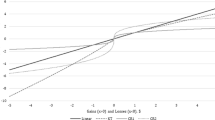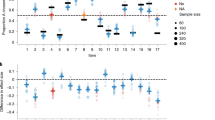Abstract
Psychological experiments have established that the classical expected utility model appears descriptively inadequate. Viscusi's prospective reference theory attempts to reconcile the expected utility model with many of these experiments by supposing that individuals have prior expectations about the utility they can expect to get from lottery payoffs. Bayesian theory then implies that individuals revise lottery probabilities in light of these prior expectations before choosing among lotteries so as to maximize expected utility. But Viscusi's theory cannot account for nonmonotonic or intransitive behavior. This article develops an extension of Viscusi's model with correlated prior beliefs that does account for nonmonotonic and intransitive behavior.
Similar content being viewed by others
References
Allais, M. (1979). “The Foundations of a Positive Theory of Choice Involving Risk and a Criticism of the Postulate and Axioms of the American School.” In M., Allais and O., Hagen (eds.), Expected Utility Hypothesis and the Allais Paradox. Boston: D. Reidel Publishing Company.
Beyer, W. (1981). Standard Mathematical Tables. Boca Raton, FL: CRC Press.
Bordley, R. and G, Hazen. (1991). “SSB and Weighted Linear Utility as Expected Utility with Suspicion,” Management Science 4, 396–408.
Chew, S. (1983). “A Generalization of the Quasilinear Mean with Applications to the Measurement of Income Inequality and Decision Theory Resolving the Allais Paradox,” Econometrica 51, 1065–1092.
Fishburn, P.C. (1988). Nonlinear Preference and Utility Theory. Baltimore: Johns Hopkins University Press.
Harrison, J. (1977). “Independence and Calibration in Decision Analysis,” Management Science 25, 320–328.
Hey, J. (1984). “The Economics of Optimism and Pessimism,” Kyklos 37, 181–205.
Hogarth, R. and H., Einhorn. (1990). “Venture Theory: A Model of Decision Weights,” Management Science 36, 780–803.
Jeffreys, H. (1961). Theory of Probability. Oxford: Oxford Press.
Jeffrey, R. (1965). The Logic of Decision. New York: McGraw-Hill.
Kahneman, D. and A., Tversky. (1979). “Prospect Theory: An Analysis of Decision under Risk,” Econometrica 47, 263–291.
Lichtenstein, S. and P., Slovic. (1971). “Reversals of Preferences between Bids and Choices in Gambling Decisions,” Journal of Experimental Psychology 7, 89.
Machina, M. (1987). “Choices under Uncertainty: Problems Solved and Unsolved,” Journal of Economic Perspectives 1, 121–154.
Morris, P. (1977). “Combining Expert Judgment: A Bayesian Approach,” Management Science 23, 679–693.
Raiffa, H. and R., Schlaifer. (1961). Applied Statistical Decision Theory. Cambridge, MA: Harvard University Press.
Viscusi, W. (1989). “Prospective Reference Theory: Toward an Explanation of the Paradoxes,” Journal of Risk and Uncertainty 2, 235–264.
Author information
Authors and Affiliations
Additional information
This article was first presented at the 1990 Economic Sciences Association Meeting. Developing an explicit multilottery suspicion model (which might suggest directions for a multivariate SSB model) was a problem originally posed by I. LaValle.
Rights and permissions
About this article
Cite this article
Bordley, R.F. An intransitive expectations-based bayesian variant of prospect theory. J Risk Uncertainty 5, 127–144 (1992). https://doi.org/10.1007/BF00057567
Issue Date:
DOI: https://doi.org/10.1007/BF00057567




